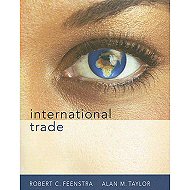|
International Trade
|
|
Robert C. Feenstra, Alan M. Taylor
|

|

The twenty-first century is an age of unprecedented globalization. In looking at existing texts, we saw that the dramatic developments of recent years had not been incorporated into a newly written undergraduate text. […] With this book, we have expanded the vision of international economics to encompass the latest theory and events in the world today. [...]
New Features
Each chapter includes several new features that bring the material alive for the students, and include:
• Applications, which are integrated into the main text and use material that has been covered to illuminate real-world policies, events, and evidence;
• Headlines, which show how topics in the main text relate directly to media coverage of the global economy;
• Side Bars, which include topics that, while not essential, are still of interest;
• Net Works boxes, which provide an opportunity for the students to explore chapter concepts on the Internet.
In addition, this book is issued in a combined edition (International Economics) and in two split editions (International Trade and International Macroeconomics) allowing greater flexibility for instructors to assign their preferred text and keep costs down for students.
New Topics and Approaches
[…] New topics covered in the international trade portion of International Economics or International Trade include the foreign outsourcing of goods and services (Chapter 6); tariffs and quotas under imperfect competition (Chapter 9); and international agreements on trade, labor, and the environment (Chapter 11). These topics are in addition to core chapters on the Ricardian model (Chapter 2), the specific-factors model (Chapter 3), the Heckscher-Ohlin model (Chapter 4), trade with increasing returns to scale of imperfect competition (Chapter 6), import tariffs and quotas under perfect competition (Chapter 8), and export subsidies (Chapter 10).
New chapters… include the gains from financial globalization (chapter 17 in the combined edition, or Chapter 6 in the International Macroeconomics ) split edition, fixed versus floating regimes (Chapter 19 or Chapter 8), and exchange-rate crises and the operation of pegs (Chapter 20 or Chapter 9). […]
|
|
